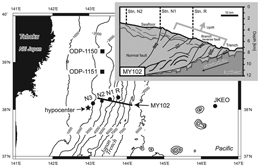Research Abstract
2011-東北地方太平洋沖地震による深海環境の擾乱
Disturbance of deep-sea environments induced by the M9.0 Tohoku Earthquake
2012年2月16日 Scientific Reports 2 : 270 doi: 10.1038/srep00270

東北地方太平洋沖地震が深海環境に及ぼす影響を調べるため、地震から36日および98日後に深海調査を実施した。36日後における深層海水の透過度異常は、海溝軸付近で通常時より遙かに大きく(約35%)、広範に(厚さ約1500m)わたっており、これは海底表面の堆積物が地殻変動により拡散したためと考えられる。この堆積物の拡散と関連した化学物質の流入に加えて、海底下深部からの13Cに富んだメタンの流入も示唆された。この海底下深部からのメタンの流入は、地震とその余震が引き金となって海底下の水文地質学的構造に変化をもたらしたことに由来すると考えられる。深海の原核生物の菌数と、特定の深海微生物群は、地震の36日後では上昇していたが、98日後には減少していた。これらの変化は、地震後に深海環境で起こっている化学環境と微生物群集の変遷をスナップショット的に捕らえたものかもしれない。
- 海洋研究開発機構 プレカンブリアンエコシステムラボユニット
- 海洋研究開発機構 海底資源研究プロジェクト
- 海洋研究開発機構 海洋・極限環境生物圏領域
- 高知大学 海洋コア総合研究センター
- 海洋研究開発機構 地球環境変動領域
- 北海道大学 理学研究院
- 海洋研究開発機構 高知コア研究所
The impacts of the M9.0 Tohoku Earthquake on deep-sea environment were investigated 36 and 98 days after the event. The light transmission anomaly in the deep-sea water after 36 days became atypically greater (∼35%) and more extensive (thickness ∼1500 m) near the trench axis owing to the turbulent diffusion of fresh seafloor sediment, coordinated with potential seafloor displacement. In addition to the chemical influx associated with sediment diffusion, an influx of 13C-enriched methane from the deep sub-seafloor reservoirs was estimated. This isotopically unusual methane influx was possibly triggered by the earthquake and its aftershocks that subsequently induced changes in the sub-seafloor hydrogeologic structures. The whole prokaryotic biomass and the development of specific phylotypes in the deep-sea microbial communities could rise and fall at 36 and 98 days, respectively, after the event. We may capture the snap shots of post-earthquake disturbance in deep-sea chemistry and microbial community responses.

